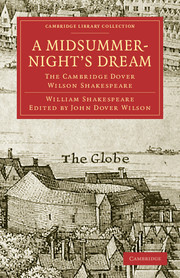INTRODUCTION
Published online by Cambridge University Press: 07 September 2010
Summary
Signor Croce says of A Midsummer-Night's Dream that ‘the little drama seems born of a smile’—and, we may add, ‘of a Sunday’—if the old proverb be true that ‘a Sunday's child is full of grace.’ It is sister, in a fashion, to Love's Labour's Lost; but a wiser, more beautiful sister, and with far fewer briars around the palace, for editor or reader. To the approaching lover she seems at first to present a stout hedge for entanglement. To misquote Dogberry, she has two Quartos and everything handsome about her. But in her, as in Silvia,
beauty lives with kindness.
There is small trouble over the text of this play, and nothing—unless we choose to make it more—to worry us about ‘origins.’
The story of the text—with which, according to our custom, we deal in a separate chapter—runs simply enough for our purpose in this Introduction. There are two known Quartos, both bearing the date 1600 on their title-pages. The one, usually known as Q1, was entered to the publisher, Thomas Fisher, in the Register of the Stationers' Company in that year.
The second, which bears the name of James Roberts on its title-page, was not entered in the Register. For long there was never a doubt that this Second Quarto belonged to the date it advertised: until the researches of Greg and Pollard—working on minutiae, including water-marks—conclusively established that the date 1600 is fraudulent and that the book belongs to 1619, having been designed in that year to make one of a set of collected plays.
- Type
- Chapter
- Information
- A Midsummer Night's DreamThe Cambridge Dover Wilson Shakespeare, pp. vii - xxiPublisher: Cambridge University PressPrint publication year: 2009First published in: 1924



